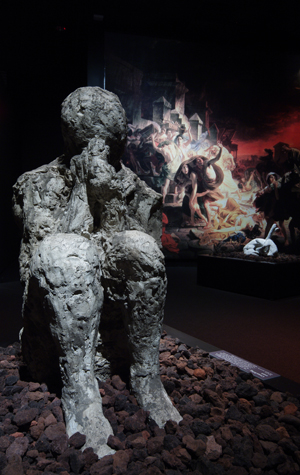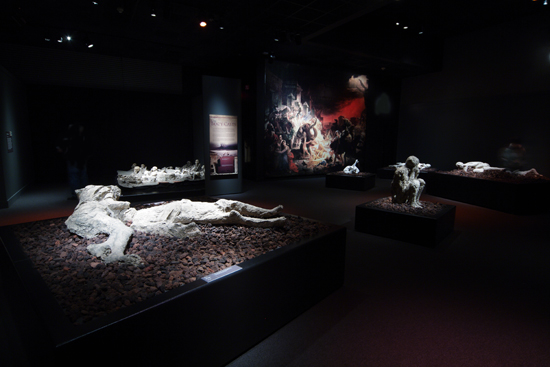Still Devastating 2,000 Years Later
Museum of Science presents life and inescapable death in Pompeii

The guard dog struggles to dig his way up through the volcanic ash as it falls around him. His paws scrape at the air. He twists madly to free himself from his chained collar. It is all in vain: the animal suffocates in the toxic ash on August 24, AD 79, in the Roman city of Pompeii.
This small story is told by a riveting resin cast of the dog in the exhibition A Day in Pompeii at Boston’s Museum of Science. It is one of many stories related through 250 artifacts of the day the ancient city was buried alive by the volcanic eruption of Mount Vesuvius. The New England premiere of an exhibition making its second tour of the United States includes objects both extraordinary and mundane, from 13 wall-sized frescoes to a carbonized loaf of bread that resembles a blackened mushroom top.
Nearly 2,000 years after the blast, we are left with a wormhole into antiquity, one that shows us, among other things, how like ourselves these Romans were. They scribbled graffiti on city walls, bought lunch from take-out stands, and crowded into sports coliseums. Unlike us, they ate dinner reclining on couches, owned slaves, and used urine to bleach their togas. In another departure, erotic art, from sculpture to frescoes, decorated most households, and later mortified early archaeologists.
At its peak, Pompeii was a prosperous port town along the Sarno River south of Naples and a vacation hot spot for Romans. About 20,000 people lived along well-paved, gridded streets lined with private homes, open-air markets, and shops. The city had running water, a public swimming pool, and a cutting-edge amphitheater.

The Museum of Science exhibition includes an animated film showing how the volcano quickly made hash out of this orderliness. Around 1 p.m. on August 24, it rocketed a column of smoke into the sky. Ash rained down on the city. Later that day, Vesuvius finished off the job with a pyroclastic surge, a kind of tsunami of deadly hot gas and debris, that blasted down the mountain at speeds of up to 500 mph.
The film brings the eruption to life, but it’s the 10 resin molds of people and a grouping of skeletons that make the disaster hit home. Realizing that hollows in the ash were the spaces left by decomposed bodies, 19th-century archaeologists injected them with plaster to re-create the human forms. Modern archaeologists use resin instead of plaster.
Even today in Pompeii, the forms are left where they fell, along city streets and staircases. In the exhibition, their white forms lie atop a rubble of small rocks, artfully illuminated by museum lighting. Their small hands cover their mouths. One man reaches out to a woman. A slave, metal shackles still on his ankles, lies prone, as if he ran until his final step. A dog grimaces with his last breath.
A Day in Pompeii runs through February 12 at the Museum of Science, One Science Park, Boston. Tickets to the exhibition are $27 for adults, $24 for children ages 3-11, and include general admission to the museum. They can be reserved by calling 617-723-2500. Advance reservations are recommended. The exhibition is open Saturday to Thursday, 9 a.m. to 5 p.m. and Friday, 9 a.m. to 9 p.m. On Thursday, January 19, from 6 to 9 p.m., the museum will hold a Science Social, where people can view the exhibition as well as enjoy Italian food and cocktails. Tickets are $25 and be purchased here .
Comments & Discussion
Boston University moderates comments to facilitate an informed, substantive, civil conversation. Abusive, profane, self-promotional, misleading, incoherent or off-topic comments will be rejected. Moderators are staffed during regular business hours (EST) and can only accept comments written in English. Statistics or facts must include a citation or a link to the citation.